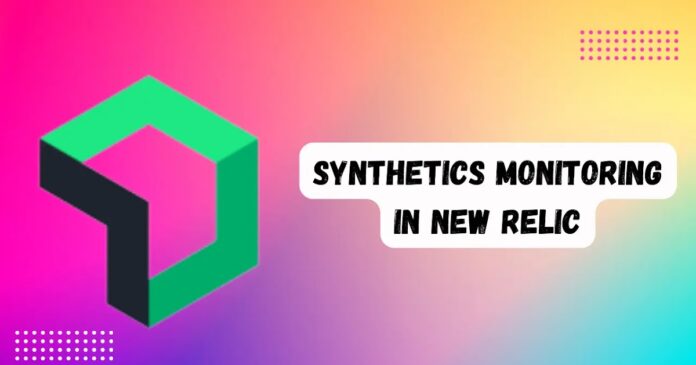Introduction
How to Get Synthetics Monitoring to Work in New Relic: How to Set It Up A crucial component of contemporary application performance monitoring (APM) methodologies is synthetic monitoring. Synthetic monitoring offers useful insights into the performance and availability of applications by mimicking user interactions and transactions. Leading APM tool New Relic has strong features for synthetic monitoring. The performance of your apps can be proactively monitored and improved by following the instructions in this article on how to set up and configure synthetic monitoring in New Relic.
Understanding Synthetic Monitoring
How to get Synthetics Monitoring to Work in New Relic: How to Set It Up In order to simulate real-world settings and gather statistics on application performance, synthetic monitoring entails modelling user interactions and transactional behaviour. It enables remote monitoring of crucial factors including response times, accessibility, and operation.
Setting Up a New Relic Account
How to Get Synthetics Monitoring to Work in New Relic: How to Set It Up You must register for a New Relic account in order to begin using synthetic monitoring in New Relic. To make an account, go to the New Relic website and complete the signup instructions. You will have access to the New Relic platform and its selection of monitoring tools after you register.
Creating Synthetic Monitoring
Synthetic monitors are employed by New Relic to mimic user interactions and business transactions. They can be developed to evaluate certain workflows, gauge performance from several sites, and keep an eye on important transactions. You can proactively find performance issues before they have an impact on actual users by making synthetic monitoring.
Configuring Monitor Scripts
You can create unique scripts for your synthetic monitors using New Relic’s robust Synthetics Scripting scripting language. When simulating user interactions, the monitor should adhere to the instructions in these scripts. To interact with web pages, manage forms, and check responses, you can make use of a variety of functions and techniques.
Defining Monitor Options
You can define several options for How to Get Synthetics Monitoring to Work in New Relic in addition to customising the script. These choices relate to the monitor’s execution location, its frequency, and the anticipated response time criteria. By accurately setting these options, you can make sure that your synthetic monitors mimic actual conditions and gather pertinent performance information.
Analysing Synthetic Monitoring Results
You may analyse the output of your synthetic monitors with the help of New Relic’s robust collection of analytics and reporting options. You can see specific availability data, response times, and performance indicators. Utilising these insights will enable you to spot patterns, address problems, and improve the functionality of your application.
FAQs
What does New Relic’s synthetic monitoring entail?
A1: New Relic uses synthetic monitoring, which simulates user interactions and transactions to keep track on the effectiveness and availability of applications. It enables you to proactively spot problems before they have an effect on actual users.
How can I configure synthetic monitoring in New Relic, question two?
A2: Use the following procedures to set up synthetic monitoring in New Relic:
- Visit the New Relic website and register for an account.
- Go to the synthetic monitoring portion of the New Relic platform.
- Make fictitious displays that mimic user actions and transactions.
- Set up monitor scripts to specify the procedures the monitor should adhere to.
- Establish monitor parameters including execution time, frequency, and thresholds.
- Review the information and findings from the reporting features of New Relic.
In New Relic, how can I build simulated monitors?
A3: In New Relic, you can make synthetic monitors by:
- You can access the synthetic monitoring section by logging into your New Relic account.
- Select “Create a Monitor” and provide the required information, including the URL and monitor name.
- Choose the type of monitor you wish to build, such as a programmed, API, or browser monitor.
- Set up other options, such as where the monitor will operate from.
- Save the monitor, and it will begin operating in accordance with the specified parameters.
What do New Relic monitor scripts do?
A4: In New Relic, monitor scripts are unique scripts that specify the procedures a synthetic monitor should adhere to. You may interact with web sites, manage forms, validate replies, and carry out other operations using these scripts, which make use of New Relic’s Synthetics Scripting language.
How can I set up monitor routines in New Relic?
A5: New Relic monitor script configuration is as follows:
- Open the desired synthetic monitor for configuration.
- Find the script section, and then describe the desired actions using the Synthetics Scripting language.
- Use the tools and techniques offered by New Relic to communicate with websites and verify responses.
- The synthetic monitor will run the script if you save it during its runtime.
Conclusion
The key to a successful APM strategy is synthetic monitoring. You can proactively monitor your apps, spot potential performance bottlenecks, and improve user experiences by using New Relic’s synthetic monitoring features. Creating synthetic monitors, establishing monitor scripts, and setting up other synthetic monitoring settings in New Relic have all been covered in this article’s overview. Defining the options for the monitor and examining the monitoring data. Utilising synthetic monitoring to guarantee the best performance and availability of your apps is possible by following these procedures.


